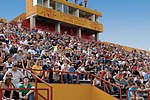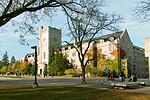Guelph Airport

Guelph Airport (TC LID: CNC4) is located in the southeastern part of Guelph/Eramosa at its border with Guelph in Ontario, Canada. It consists of two runways, 14/32 and 06/24. Although known to residents as the "Guelph Airport" or "Guelph Airpark", it is actually an aerodrome, being registered, and not certified, by Transport Canada. The airport is classified as an airport of entry by Nav Canada and is staffed by the Canada Border Services Agency (CBSA) on a call-out basis from the Region of Waterloo International Airport on weekdays and the John C. Munro Hamilton International Airport on weekends. At this airport the CBSA handles general aviation aircraft only, with no more than 15 passengers.Founded in 1954 by aviation enthusiast Len Ariss, the aerodrome remained in the Ariss family until August 2011 when it was sold to Inglis Berry.
Excerpt from the Wikipedia article Guelph Airport (License: CC BY-SA 3.0, Authors, Images).Guelph Airport
Skyway Drive, Guelph/Eramosa
Geographical coordinates (GPS) Address Nearby Places Show on map
Geographical coordinates (GPS)
| Latitude | Longitude |
|---|---|
| N 43.563611111111 ° | E -80.195833333333 ° |
Address
Guelph Airpark
Skyway Drive
N1L 1P4 Guelph/Eramosa
Ontario, Canada
Open on Google Maps






